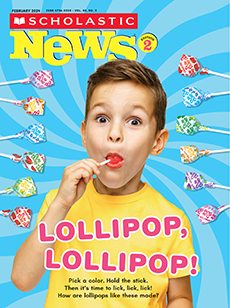Frozen in Ice Lesson Plan
Academic Standards
Reading Objective:
Children will examine how freezing weather and water combine to cover a lighthouse in ice.
Science Focus:
winter weather
ELA Skills:
key details, writing, vocabulary, text features
Page 4 Skill:
read a map
Vocabulary:
spray, frigid, surface, blizzard, sleet, freezing rain, wind chill
CCSS:
RI.2.1, RI.2.4, RI.2.5, RI.2.10, L.2.1, W.2.8, SL.2.3
Guided Reading Level:
L
Lexile Level:
540L
Provide students with some background on ice, snow, and winter weather.
Build background knowledge (10 min.)
Watch our video "When Water Freezes." After children have finished watching the video, discuss the following questions:
- What does water turn into when it freezes? (ice)
- Is water a solid or a liquid? (a liquid)
- Is ice a solid or a liquid? (a solid)
Preview vocabulary (3 min.)
Next, play the online vocabulary slideshow. This issue’s featured words are spray, frigid, surface, blizzard, sleet, freezing rain, and wind chill.
Set a purpose for reading (5 min.)
- Pass out the issue, and discuss the cover. What season do students think it is in the picture? What kind of weather might have caused what they see?
- Next, read the As You Read prompt: “Think about the different things winter weather can do.” Encourage children to think about this prompt as they read.
Read together (20 min.)
Pass out the Read and Think printable. Use it to check comprehension as you read the issue together, pausing to ask the questions.
- Students will love building a personalized digital snowman with the Build Your Own Snowman game!
You can use our printable worksheets to focus on important science and ELA skills. Here’s how.
ELA Focus: Vocabulary (15 min.)
- Use the Word Work printable to deepen students’ understanding of the words spray, blizzard, freezing rain, and sleet.
Editor’s Pick: Science Experiment (15 min.)
- The Ice Fishing Experiment skill sheets guide you through performing an easy experiment with students. All you need are a few simple materials: ice, a dish, a bit of string, and some salt!
- With easy-to-follow directions and a predictions and observations page, your little scien
ELA Focus: Text Features (15 min.)
- The Text Feature Hunt skill sheet is a great way to reinforce nonfiction text features. Students can do it independently or with a partner. They can first circle the text feature in the article, and then record it on the sheet.
Assessment: Reading Checkpoint (15 min.)
- Pass out the Reading Checkpoint to review key concepts from the issue and assess students’ proficiency on key nonfiction reading skills.
Here are two past issues you can use to extend your lesson on ice and cold weather:
- Frozen Hotel, January 2020. Would kids like to stay at a hotel made entirely of ice? With this issue, they get all the details to make a decision!
- The Volcano That Stopped Summer, April 2020. This issue covers the story of “The Year Without a Summer”— when a volcano halfway around the world caused temperatures to drop in the summer months in the U.S.!
You can find a higher-Lexile-level and a lower-Lexile-level version of the article online here:
- Higher Lexile level: 590L
- Lower Lexile level: 470L
